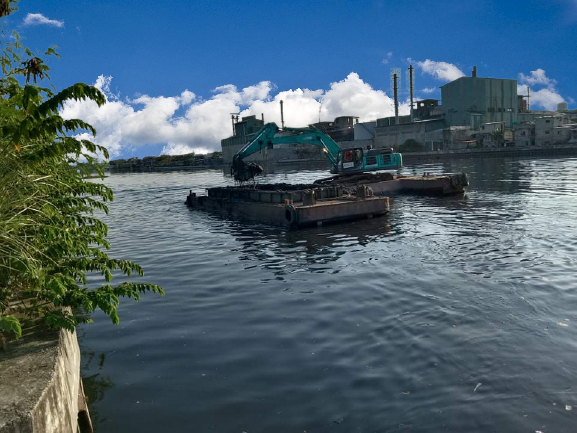It’s not too late to solve Bulacan’s perennial problem with flooding, and San Miguel Corporation (SMC) president and CEO Ramon S. Ang has a solution: an extensive cleanup of polluted river systems and waterways in and around the province, which he vowed SMC itself would implement using its own resources at no cost to the government and the people of Bulacan.
Ang made this commitment to Department of Environment and Natural Resources (DENR) Secretary Maria Antonia Yulo-Loyzaga in a recent meeting, where he presented the status of SMC’s massive river cleanup initiatives including the Pasig River, Tullahan River, and the San Juan River.
The company has already spent some P3 billion to desilt and remove solid wastes from the polluted waterways. Ang also outlined plans to fully shift its river rehabilitation efforts to Bulacan in the coming months.
SMC, which has multiple investments in Bulacan —including the MRT-7 project, the Bulacan Bulk Water Supply facility, and the biggest development in the country to date, the P740-billion New Manila International Airport —has, in recent years, been a prime mover and advocate for cleaning up major river systems in Metro Manila.
Shifting river rehab efforts to Bulacan
“Our Pasig River cleanup is almost complete. After about two years, we are nearing our target of 1.4 million tons of silt and waste removed. We have also started desilting and waste extraction activities at the Meycauayan River and Maycapiz/Taliptip River. This is part of our plan to clean up rivers in the Bulakan-Obando-Meycauayan-Marilao-Bocaue-Guiguinto River System, which is critical to addressing flooding throughout the southern part of Bulacan,” Ang said.
SMC’s flood mitigation program for Bulacan initially covered rivers surrounding the future site of the New Manila International Airport. However, upon the request of local government units of Bulacan, SMC expanded the program to other tributaries outside of the MMORS.
“It’s very unfortunate every time there is a typhoon, so many people in Bulacan have to suffer. Flooding has been a problem in the province ever since. With the growth in population, the emergence of settlements and developments, and no extensive and sustained effort to clean up the rivers, the situation has only gotten worse,” Ang said.
“But I am confident that with this project to extensively clean up our rivers and with the support of our provincial and local governments and the DENR, we can significantly increase the carrying capacity of our rivers and help solve flooding once and for all,” he added.
Airport project not the cause of flooding
Ang also addressed allegations by some that the airport project is the cause of flooding in the province, pointing out that flooding had already been a major problem, long before government approved the airport’s construction in the province, just north of Metro Manila.
“There are many contributing factors to flooding. Bulacan has many low-lying areas. Another is land subsidence caused by over-extraction and the depletion of ground water. In fact, that is one of the reasons why we invested in putting up the Bulacan Bulk Water System Project some years back —to provide potable water to residents without having to resort to unsustainable use of ground water,” Ang explained.
He added: “Degradation, siltation, and pollution of our rivers are of course major causes of flooding. Because of these, rivers become shallow and their flood carrying capacity is severely diminished, resulting in river overflow and floods. The proliferation of fish ponds in coastal areas has also contributed to severe flooding in the province”.
SMC has already started cleaning up rivers around the airport project site as part of the overall design and long-term maintenance of the country’s largest international gateway.
These flood mitigation efforts are seen to also benefit towns near the airport.
“We are deeply invested in the future as well as the well-being of Bulacan and its residents. We would not pour in billions in resources if we didn’t consider all possible risks, including flooding in the province. As with any major undertaking of this magnitude, extensive studies were done even before construction started. And even now, we continue to work with experts and to consistently ensure we adhere to the highest environmental and social standards and regulations,” Ang said.
Heavily-silted Pampanga river brought floods to Calumpit, other towns
Ang also pointed out that heavily-flooded areas during the last typhoon, particularly Calumpit and Hagonoy, located far from the airport project, were affected by overflow from the heavily-silted Pampanga River aggravated by the release of water from some dams.
SMC is already looking to extend its river desilting and cleanup initiative beyond Bulacan’s rivers, to other critical tributaries throughout Central Luzon.
“With our experience in cleaning up Tullahan and Pasig Rivers, the modern equipment we have invested in over the years, and the technical know-how of our personnel, I think we are more than ready to take on the challenge of expanding the efforts to the rest of Bulacan and also Pampanga,” Ang added.
Since 2020, the company has been undertaking major river cleanup programs at no cost to government, to help mitigate flooding in and around Metro Manila,
Apart from its ongoing cleanup of the Pasig River, last year, SMC completed its P1-billion Tullahan river cleanup project. It extracted more than 1.12 million metric tons of silt and solid wastes from the river.
Currently, Ang said SMC is has cleaned up some 4.45 kilometers out of an inital 13-kilometer target along the Taliptip/Maycapiz River and the Meycauayan River. A total of 543,266 metric tons of silt and solid waste have now been removed.
Meycauayan River, one of the tributaries in the Marilao-Meycauayan-Obando River System (MMORS), has been named as one of the world’s top 10 tributaries that emit the highest share of plastics to the oceans.
Others in the list are the Pasig River, Tullahan River, Pampanga River, Libmanan river, Rio Grande de Mindanao, and Agno river.














